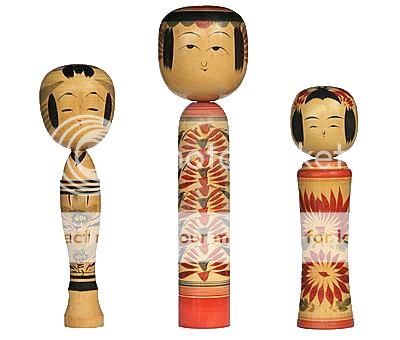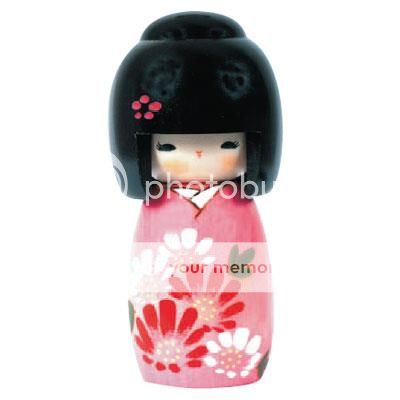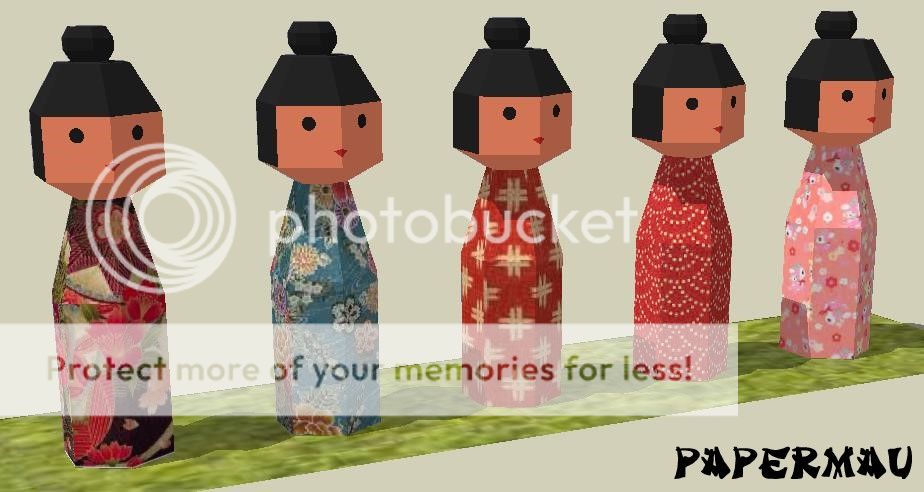 |
| Classic Kokeshi Dolls |
According to Wikipedia,
Kokeshi are Japanese dolls, originally from
northern Japan. They are
handmade from wood, have a
simple trunk and an
enlarged head with a few thin,
painted lines to define the face. The body has a
floral design painted in red, black, and sometimes yellow, and
covered with a layer of wax. One
characteristic of kokeshi dolls is their
lack of arms or legs. The
bottom is marked with the signature of the artist. The
origin and naming of kokeshi is
unclear, with h
istorical ateji spellings including 小芥子, 木牌子, 木形子, and
木芥子. The
hiragana spelling こけし was agreed on at the
All-Japan Kokeshi Exhibition (
全国こけし大会) at
Naruko Onsen in August 1939. A
plausible theory is that
"kokeshi" is derived from wooden (木 ki, ko?) or
small (小 ko?), and
dolls (芥子 keshi?). Kokeshi were first produced by kijishi (木地師), artisans proficient with a
potter's wheel, at the
Shinchi Shuraku, near the
Tōgatta Onsen in Zaō from where
kokeshi making techniques spread to other spa areas in the Tōhoku Region. It is said that
these dolls were originally made during the middle of the Edo period (1600–1868) to be
sold to people who were visiting the hot springs in the north-east of the country.
 |
| A Modern Kokeshi Doll |
De acordo com a Wikipedia,
Kokeshi são bonecas japonesas, originárias do
norte do país. Elas são
manufaturadas em madeira, possuindo
um tronco simples e uma grande cabeça, pintadas com finas linhas para delinear o rosto. Seu corpo tem
desenhos florais, pintados sobre fundo vermelho, preto, e algumas vezes amarelo, e
nvernizadas por uma camada de cera. Uma
marcante característica das
Kokeshi é a
ausência de braços e pernas.
Na parte inferior é marcada com a assinatura do artista. As
Kokeshi foram
produzidas inicialmente pelos Kiji-shi (artesãos da madeira), em Shinchi, em
Tagata (Miyagi), de onde
a técnica se espalhou para outras áreas das estâncias termais da região de Tohoku. Diz-se que estas bonecas
foram feitas originalmente em meados do período Edo (entre 1600-1868) para serem
vendidas como souvenires aos visitantes das fontes termais do nordeste do Japão.
Download soon. / Download em breve.
More Papermau Next Projects related posts:
Medieval Dock Paper Model - by Papermau - More One Next Project
The Limo Paper Model - by Papermau - Next Project
Old House In Olaria Paper Model - by Papermau - Next Project
Los Pollos Hermanos Roadside Cafe - by Papermau - Next Project




No comments:
Post a Comment